Fitbit vs Garmin: Which one is worthy of a place on your wrist?
Fitbit vs Garmin: We break down exactly which of the fitness trackers and smartwatches are really worth your money.
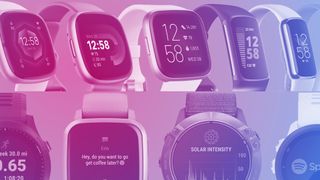
Fitbit vs Garmin. Which of these two tech brands should you invest in this Black Friday sale? They’re two of the biggest and most well known tech brands around, and while both produce some of the best fitness trackers money can buy, they offer completely different takes on what a wearable should be.
Fitbit introduced millions to the concept of fitness tracking, and kick-started competitive step counting as a trend. Garmin typically appeals to a much more hardcore crowd. If you see a fitness watch on a marathon runner, there’s a good chance it will be a Garmin.
The best Garmin watches can do loads of stuff Fitbits can’t, like let you navigate offline using a map on your wrist. And they deal in deeper stats that are ideal for analysing your performance and fitness over time.
The best Fitbit watches have a completely different vibe. They are more concerned with health and wellness than ways to nail down exactly how good a runner, cyclist or triathlete you are.
This can make Fitbits seem fluffier at times, but a couple of higher-end watches like the Sense 2 and Charge 5 have sensors not seen in any Garmin. They also tend to be better-looking, or at least better aligned with the stylistic norms of popular wearables.
In this article we’re going to dig further into the differences between Fitbit and Garmin watches, and look at most of the models you may want to consider buying.
What models are available?
Garmin has a vast number of models available, with various niche watches to suit different sporting styles. Fitbit, on the other hand, is much more straightforward.
Up at the top of Fitbit’s range we have the recently released Fitbit Sense 2, a $299/£269 watch with maxed-out features. The Fitbit Charge 5 is a mid-range offering from the company with a smaller screen. Further down the line we have the Fitbit Luxe and Fitbit Inspire bands.
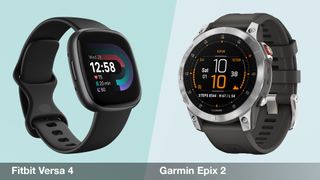
To give a similar run-down of the Garmin line-up would take far too long, so let’s stick to the ranges. At the top sit the Epix 2 and Fenix lines, including the Garmin Fenix 7 Sapphire Solar. These are expensive, but are also brilliant hardcore exercise watches.
The Forerunner series (which includes one of their latest models, the Garmin Forerunner 955) offers enthusiast-grade features for less money.
Garmin’s mid-range Instinct watches are aimed at outdoorsy folks, and offer excellent battery life but a more basic, if very clear, display.
The Garmin Venu models are the closest to Fitbit’s smartwatch-style models. You get OLED screens, slicker-looking designs, but the battery doesn’t last as long as some others.
The Garmin Vivoactive combines a more casual appearance with an MIP screen, which only gets clearer out in bright sunlight. And down towards the bottom of the range, casual tracking lines include the Vivosmart and Vivomove.
There's bound to be something that will appeal to you in the Garmin range, as there are so many options to choose from. But if you're after a leaner range of models (and a cheaper, more straightforward watch) you might prefer a Fitbit model.
Which is cheaper?

Fitbit and Garmin are not budget brands. If you’re after something truly cheap, check out Realme, Xiaomi, Honor and Huawei (we have a full round-up of the best budget fitness trackers, too). However, Garmin’s prices get flat-out intimidating at the higher end, and Fitbit’s simply do not.
The top-spec Fitbit Sense 2 costs $299/£269. That only gets you a mid-range Garmin like the Instinct 2 or Venu 2.
Garmin’s priciest variant of the Epix 2 costs $999/£899, and that is not even the most expensive watch Garmin makes. Fitbit wouldn’t dream of making something so pricey.
You could argue the two brands are relatively evenly priced, from another perspective, though. An older Fitbit Sense (like the one in the image above) and Garmin Venu 2 are of comparable quality, are similar in price, and simply have differing strengths. However, Garmin can’t match the value of the Fitbit Charge 5 with anything in its catalogue.
Which is more accurate?

Based on our testing of many watches and bands from the Garmin and Fitbit ranges, Garmin has a clear edge for accuracy.
This plays out most clearly in heart rate results during exercise. Watches like the Garmin Fenix 7 (shown above) are super-accurate, even in challenging workouts with short, sharp bursts of high exertion.
Some Fitbits can miss these peaks entirely on occasion, which has a knock-on effect on other stats.
The latest Garmin watches also have superior GPS, with Multi-Band support that should result in a better signal in environments in which other trackers might struggle. We think most owners will be perfectly happy with Fitbit’s GPS, though.
Fitbit does have an edge in one area, though: sleep tracking. In a 2020 study published in Nature and Science of Sleep, Fitbit was found to have greater sleep accuracy than other brands.
Which looks better?
What makes a good-looking watch? It’s up for debate, but we think the majority of people will find most Fitbit wearables prettier than Garmin’s.
Garmin does not make anything quite as sleek and reserved as the Fitbit Luxe, for example. We also like how the Fitbit Charge 5 combines quite high-end health features with fairly petite, cute styling.
The traditional Garmin approach leans more into an aesthetic designed to appeal to adventuring types. In some models the bezel extends above the display, for added protection, and cases may be extra bulky to facilitate extreme water resistance.
Practicality and ruggedness matter a lot to Garmin. Not all of its lines are so pragmatic, though.
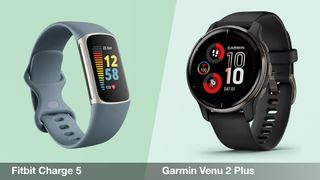
The Garmin Venu series aims for a much more approachable, smartwatch-like appearance. Its Vivomove looks just like an analog watch, but has a screen hidden under the surface.
Not all Garmins look like they only belong on the wrists of marathon runners. But if you’re after that classic low-key wearable look, Fitbit has a clear lead.
Which brand offers more features?
Garmin offers far more hardcore fitness features than Fitbit. However, none of its watches have two of the features found in the Fitbit Charge 5 and Sense 2.
These are ECG, echocardiogram, and EDA, electrodermal activity. The first monitors your heart rhythm to check for possible abnormalities, signs of atrial fibrillation, while EDA analyzes your skin’s sweat production, and uses that data as a stress indicator.
While the Garmin Venu 2 Plus reportedly has “hidden” ECG hardware, no Garmin watch has either of these features. And that kind of makes sense. Garmin makes fitness watches, not ones intended to check heart health.
Instead, it delivers stacks of exercise features not seen elsewhere. The company's top-end watches allow you to download continents’ worth of maps and use them to navigate without a phone. You can also connect to bike turbo trainers and control their resistance.
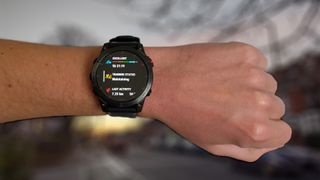
Garmin’s Connect platform lets you design your own workouts, which the watch will then guide you through. And all of this comes included as part of the experience.
Top Garmin watches also use the data they collect to let you balance your workout schedule properly. Body Battery lets you see if you’re working too hard, Training Load is an indicator of exertion in aggregate, Performance Condition gives you an idea of your training effectiveness and VO2 Max is a solid long-term indicator of fitness.
Fitbit does not go into such depth, and to unlock the full features of Fitbit watches you need to subscribe to Fitbit Premium. Long-term tracking of stats, advanced sleep tracking and Daily Readiness are all locked behind the Premium paywall — and it’s $9.99 a month to lift it.
Which is better for tracking workouts?
Garmin watches are better than Fitbits for workout tracking. Some of the pricier models are overkill for many folks, but the greater reliability of Garmin’s stats means that conclusion holds regardless.
We also like that Garmin doesn’t keep any stats behind a subscription paywall, meaning you get access to all the data you might need to track your progress towards living a healthier life.
Garmin’s exercise mode library is larger too. And it is one of the few companies that makes such an extensive list of tracking modes seem worthwhile too, with specialized stats for niche pursuits and guided sessions for things like yoga and weightlifting.
More expensive watches from the Forerunner, Fenix and Epix series will also analyze your performance during each workout and compare it to your baseline. So it might give you a “+4” score, for example, which is always nice to see.

Garmin provides loads more features for the more exercise obsessed, and manages to do the basics better too. However, if you are just looking to track regular runs we do think most will be perfectly happy with one of Fitbit’s GPS-equipped watches, such as the Fitbit Versa 4 or Fitbit Charge 5.
Which has better battery life?
Garmin makes some of the longest-lasting fitness trackers in the world. Take the Garmin Enduro 2, for example. It can last up to 550 days in its battery-saving mode, if you pick the solar charging version.
A handful of the company’s models are available in solar form. They use a ring around the display that can harvest a decent amount of solar energy, and the display itself does too, at a lower rate.
The Enduro is an outlier in terms of battery life, of course, and Garmin benefits from its favored display type. Classic Garmin watches use a transflective MIP screen that only gets clearer in bright sunlight, the polar opposite of standard LCD and OLED displays.
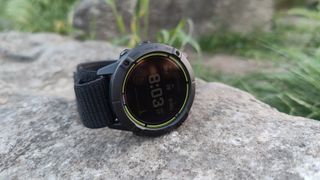
Look at the battery life of an OLED screen model like the the Venu 2 Plus and you’ll see figures much closer to Fitbit’s. It can last up to 9 days off a charge, and you can roughly half that if you use the “always on” screen mode.
The Fitbit Sense 2 and Versa 4 last “6+ days”. With these OLED watches we find they both tend to last most, but not all, of a week with multiple tracked workouts. But if you go for an MIP-screen Garmin, you can stretch that to a couple of weeks, or beyond.
Verdict

Fitbit is a more casual fitness tracking brand than Garmin. It focuses on style and approachability, and none of its wearables are as expensive as those of Garmin’s top-end lines.
The Fitbit Premium service also offers lots of video workouts and guided meditations, which may appeal. But some will end up frustrated that fairly important features are locked behind this $9.99 a month subscription.
If you are big into outdoor exercise, a Garmin is probably the better pick. Its watches have deeper fitness features, and we find the stat accuracy level to be notably higher for aspects like heart rate. We consider the Fenix 7 to be the best Garmin all-rounder, but if that seems too expensive the Forerunner 255 is a great watch to look into.
Sign up for the Live Science daily newsletter now
Get the world’s most fascinating discoveries delivered straight to your inbox.
Andrew Williams is a freelance journalist based near London. He has written about tech for over a decade, contributing to sites such as WIRED, TechRadar, TrustedReviews, Wareable, Stuff, T3, Pocket-lint and many others. When he's not covering fitness tech, he writes about mobile phones and computing, as well as cameras.

